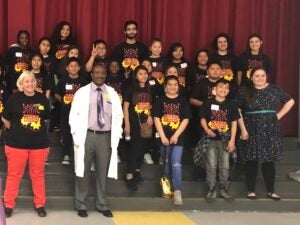 Robotics Workshop
Robotics Workshop
Originally Published May 15, 2019
The Young Scientists Program co-hosted an after-school workshop with USC Viterbi’s STEM-EOP (STEM Educational Outreach Programs) on April 8th for fourth and fifth-grade students at John W. Mack Elementary. The theme for this semester’s workshop was robotics. The students explored several robotic engineering topics through live demonstrations and hands-on activities. Dr. Darin Gray, Director of STEM Educational Outreach Programs for the USC Viterbi School of Engineering, kicked off the workshop with a presentation in which he performed a number of demonstrations with the students to engage them in the field of robotics.

Following the opening presentation, students participated in three stations to explore the software and hardware components of programming and building robots. At one station students learned about the functional role of sensors in robotic motion and how robot automation functions. They had the opportunity to program Finch Robots (provided via rental from BirdBrain Technologies LLC) to maneuver through various obstacle courses and mazes. The students worked together to program their robots using the object-oriented programming language Scratch and competed to see which robot could navigate a cardboard maze the fastest.

The second station involved an activity using Bristlebots, which are simple robots created from a toothbrush head, a coin battery, and a vibrating motor. Students created their own Bristlebot while learning about circuits and the energy required to power robots. An art component was integrated into this station, as students used their Bristlebots to create their own art pieces that they took home with them, along with their very own, personal bristlebot!


The last station at the workshop involved a game of soccer in which the players were the Finch robots. Students worked in small teams to program their Robot Finch to move in all translational (forward-backward, left-right) directions, learning and using basic software engineering principles. In order to have recognizable teams, the young scientists had to program the colors of their Robot Finch’s beak, an exercise which allowed them to explore the concept of variables through setting the different components of colored light (proportions of red, green and blue light) for the robot’s LEDs. The students then split into teams of two and controlled their finch during a game of soccer versus the opposing pair.

Thank you to USC Civic Engagement and the Good Neighbors Campaign for funding this workshop under the C-ASSETS program. Thank you for all the YSP Staff and volunteers that made this event possible.